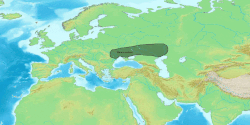
Back Idioma frichio AN لغة فريجية Arabic Frixu AST Frigiya dili Azerbaijani Фрыгійская мова Byelorussian Фригийски език Bulgarian Frigi (llengua) Catalan Frýžština Czech Phrygische Sprache German Frygšćina DSB
| Phrygian | |
|---|---|
| Region | Central Anatolia (in modern Turkey) |
| Ethnicity | Phrygians |
| Extinct | After the 5th century CE[1] |
Indo-European
| |
| Dialects | |
| Phrygian alphabet Greek alphabet | |
| Language codes | |
| ISO 639-3 | xpg |
xpg | |
| Glottolog | phry1239 |
| Part of a series on |
| Indo-European topics |
|---|
 |
|
|
The Phrygian language (/ˈfrɪdʒiən/ ⓘ) was the Indo-European language of the Phrygians, spoken in Anatolia (in modern Turkey), during classical antiquity (c. 8th century BCE to 5th century CE).
Phrygian ethno-linguistic homogeneity is debatable. Ancient Greek authors used "Phrygian" as an umbrella term to describe a vast ethno-cultural complex located mainly in the central areas of Anatolia rather than a name of a single "tribe" or "people".[5] Plato observed that some Phrygian words resembled Greek ones.[6]
Because of the fragmentary evidence of Phrygian, its exact position within the Indo-European language family is uncertain.[7][8] Phrygian shares important features mainly with Greek, but also with Armenian and Albanian. Evidence of a Thraco-Armenian separation from Phrygian and other Paleo-Balkan languages at an early stage, Phrygian's classification as a centum language, and the high frequency of phonetic, morphological, and lexical isoglosses shared with Greek, have led to a current consensus which regards Greek as the closest relative of Phrygian.[9][10][11][12][13]
- ^ Swain, Simon; Adams, J. Maxwell; Janse, Mark (2002). Bilingualism in Ancient Society: Language Contact and the Written Word. Oxford [Oxfordshire]: Oxford University Press. pp. 246–266. ISBN 0-19-924506-1.
- ^ Hammarström, Harald; Forkel, Robert; Haspelmath, Martin, eds. (2017). "Graeco-Phrygian". Glottolog 3.0. Jena, Germany: Max Planck Institute for the Science of Human History.
- ^ Obrador-Cursach 2018, p. 102:Furthermore, if Phrygian were not so-poorly attested perhaps we could reconstruct a Proto-Greco-Phrygian stage of both languages.
- ^ Obrador-Cursach 2020, p. 243:With the current state of our knowledge, we can affirm that Phrygian is closely related to Greek. This is not a surprising conclusion: ancient sources and modern scholars agree that Phrygians did not live far from Greece in pre-historic times. Moreover, the last half century of scientific study of Phrygian has approached both languages and developed the hypothesis of a Proto-Greco-Phrygian language, to the detriment to other theories like Phrygio-Armenian or Thraco-Phrygian.
- ^ Oreshko 2020, pp. 82–83: "In other words, Ḫartapus can be identified as an early Phrygian king – with the proviso that 'Phrygian', as used by the Greek authors, is an umbrella term for a vast ethnocultural complex found predominantly in the central parts of Anatolia rather than a name of a single 'people' or 'tribe'. Its ethnolinguistic homogeneity cannot be taken for granted."
- ^ Plato, Cratylus (410a)
- ^ Woodhouse 2009, p. 171: "This question is of course only just separable from the question of which languages within Indo-European are most closely related to Phrygian, which has also been hotly debated."
- ^ Obrador-Cursach 2018, p. 101: "Scholars have long debated the exact position of Phrygian in the Indo-European language family. Although this position is not a closed question because of the fragmentary nature of our current knowledge, Phrygian has many important features which show that it is somehow related to Greek and Armenian."
- ^ Cite error: The named reference
Obrador-Cursach2020was invoked but never defined (see the help page). - ^ Brixhe, Claude (2008). "Phrygian". In Woodard, Roger D (ed.). The Ancient Languages of Asia Minor. Cambridge University Press. pp. 69–80. ISBN 978-0-521-68496-5. "Unquestionably, however, Phrygian is most closely linked with Greek." (p. 72).
- ^ Woodhouse 2009, p. 171: "A turning point in this debate was Kortlandt's (1988) demonstration on the basis of shared sound changes that Thraco-Armenian had separated from Phrygian and other originally Balkan languages at an early stage. The consensus has now returned to regarding Greek as the closest relative."
- ^ Obrador-Cursach 2018, p. 101: "Brixhe (1968), Neumann (1988) and, through an accurate analysis, Matzinger (2005) showed the inconsistency of the Phrygo-Armenian assumption and argued that Phrygian was a language closely related to Greek."
- ^ Holst 2009, p. 65–66.
© MMXXIII Rich X Search. We shall prevail. All rights reserved. Rich X Search